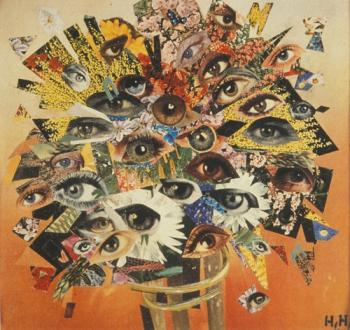Serendip is an independent site partnering with faculty at multiple colleges and universities around the world. Happy exploring!
jhunter's blog

Colleges, Prisons, and Hospitals: A Semester in Three Walled Communities
“When a woman tells the truth she is creating the possibility for more truth around her.”
---Adrienne Rich
I live in the walled community of Haverford College but also in a second institution—the hospital.
I don’t know why I haven’t spoken of these experiences in class. Or maybe that’s a lie because I know exactly why. At any given moment I am either in searing pain, trying to discretely smother the flames burning down my arm, or else I am using all my mental capacity to follow discussion while my brain is hazy from pain medication.

Movie Screening Friday Night
Hey everyone,
I'm not sure if everyone already knows about this event but wanted to let you know about a film screening tomorrow night that seems to connect quite nicely to what we've been discussing in class and also just looks rather interesting. Description of it is below...

Avatar Selection
My avatar is a Hannah Hoch image, a close-up from one of her larger works. I chose it for somewhat obvious reasons, as it depicts the face of a woman with an open mouth with text, specifically the letters ABCD, between her teeth. In addition to being visually interesting and being an image from one of my favorite artists, I thought the themes of voice and collage in the piece related quite nicely to our 360.

Names and Images
Though "Prisoners of a Hard Life" shared various statistics and facts about incarcerated women, it was not the numbers nor the narratives but the images, particularly the faces and bodies of the women, on which I want to comment. The graphic-novel style of work adds a dimension to the stories of these five women that I'm not used to seeing. In grayscale, the women come to life and, were I able to take the figures out of the harsh words of the pages and environments of the panel, it would be easy enough to insert them into a children's book--as just another illustration of a woman. In this, I think the authors allow the reader to see the humanity of women who are used to being seen as criminals first and women and mothers as a distant second and third. The ink drawings make it easier to notice similarities between people instead of focusing on differences like race or class indicators like style of dress. The stories of these five women are each unique, but, through the medium of the graphic novel, more so than the photographs or other outside images that are included, it is easy to recognize that the women in the panels are more than their childhoods, their crimes, their addictions, their race, their poverty, or any other factors I may have previously focused on to define them.

Modes of address
In Ellsworth's article, the networks of power in pedagogical relationships are compared to chocolate bands in a marble cake. I found myself thinking about what exactly Ellsworth meant by power in her article and in this example. Was she speaking of a Foucault-ian concept of discursive power within which pedagogy generated its own discussions of different enmeshed power relationships? If so, then modes of address don't merely constitute these relationships but also the spaces in which and through which people communicate. I think that the Internet, particularly chatrooms, are an interesting mode of address. Even on this discussion board, I can never be quite certain about everyone's representations, and, though I'm writing for my fellow class participants, our pedagogical relationship is not exactly as deeply personal as Ellsworth describes it in her essay. My mode of address may be specific to our class in this context, but I have to recognize that anyone with access to a computer can read my words. I'm representing myself for a contact zone that is essentially constructed of the entire world.

A Quiet Bike Ride

I am fourteen and riding my bike back from the grocery store with a pack of colored sharpies and paperclips that I need for a science project. It’s light out, sunset at least an hour away, as I pedal down my neighborhood’s sidewalks. I pass neatly trimmed lawns that look identical, making the ride feel like an endless outdoor hall of mirrors, reflecting the same brick, two-story, white-trimmed house over and over. Despite my initial anger that my parents wouldn’t be able to give me a ride to the store because of their presence at my older brother’s awards ceremony, I’m enjoying riding my bike, the translucent grocery bag on my left handlebar shuddering and flapping in the wind, my pale skin exposed to the waning sunlight of this May afternoon. The grocery store is only a mile from my house, and I am nearing the end of my ride.

Writing About Speech
Though Anna Deavere Smith raises many interesting points, I couldn't reconcile myself with her simultaneous celebration of the beauty in imperfect language and the poetic, sometimes over-written words I held in my hands. I think the greatest issue was, as she admits, trying to explain a piece that is about dialogue on the silent, static, monochromatic world of the page. I don't know if I'm reading too much, some pun intended, into her introduction, but the dissonance bothers me. Her descriptions of the interviews and audience's reactions to her play don't make me feel anything. And maybe this proves her point about the transformative nature not of words themselves but of what happens when words are spoken.
Despite this struggle with her words, I did find much of Smith's piece thought-provoking, particularly her exploration of the hesitation to mimic actually serving as an insult. She raises many interesting questions, many more than would be productive to share in this space. If I ignore your difference, do I ignore you? If I fail to speak about how I see and hear you, or if I sanitize my speech in efforts to be 'politically correct,' am I effectively transforming you into me? Is this a form of verbal genocide--the murder of the language of an oppressed group? And, if I fail to speak about my own experience, am I truly myself?

Seeing Silence
 To depict a visualization of silence, I chose Hannah Hoch's Bouquet of Eyes. It is a work that uses disparate elements to create something unsettling but also beautiful. Like Hoch's work, silence is a powerfully affective experience that causes a distinct response in each individual. It strengthens one or multiple senses, in many cases vision, but does not merely use the eye as a window through which to look but also often puts the self in the position of the object, giving time for self-reflection. It is isolating, unifying, and can appear like one thing while simultaneously being something wholly different.
To depict a visualization of silence, I chose Hannah Hoch's Bouquet of Eyes. It is a work that uses disparate elements to create something unsettling but also beautiful. Like Hoch's work, silence is a powerfully affective experience that causes a distinct response in each individual. It strengthens one or multiple senses, in many cases vision, but does not merely use the eye as a window through which to look but also often puts the self in the position of the object, giving time for self-reflection. It is isolating, unifying, and can appear like one thing while simultaneously being something wholly different.


